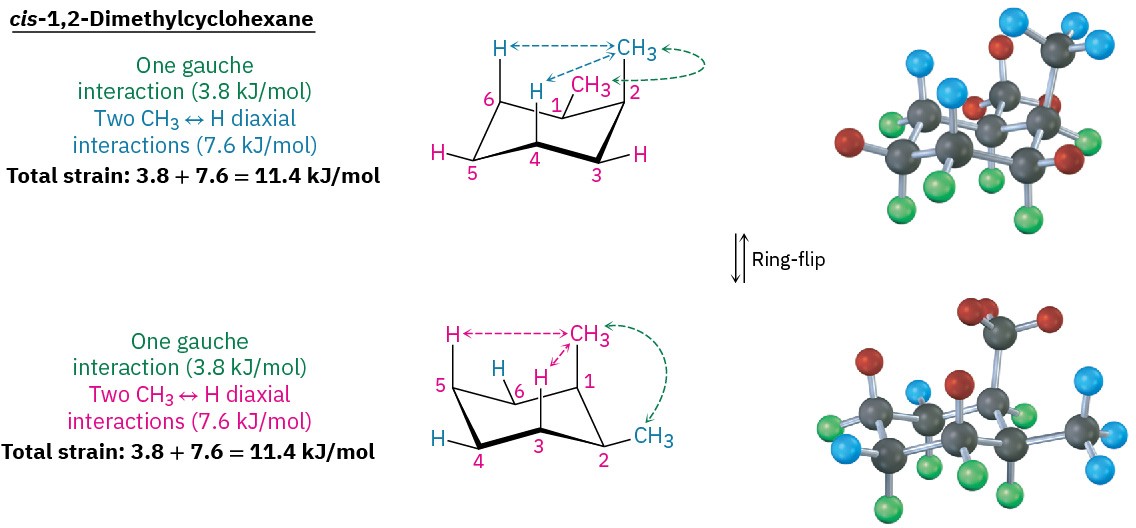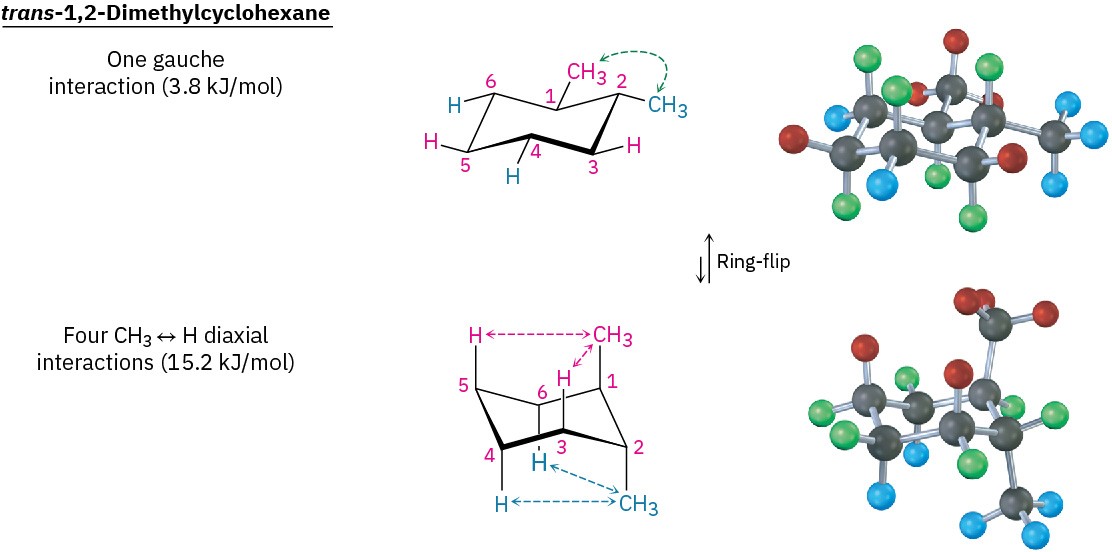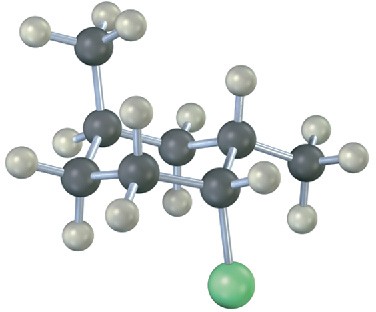2.15 Conformations of Disubstituted Cyclohexanes
Monosubstituted cyclohexanes are always more stable with their substituent in an equatorial position, but the situation with disubstituted cyclohexanes is more complex because the steric effects of both substituents must be taken into account. All steric interactions for both possible chair conformations must be analyzed before deciding which conformation is favored.
Let’s look at 1,2-dimethylcyclohexane as an example. There are two isomers, cis-1,2- dimethylcyclohexane and trans-1,2-dimethylcyclohexane, which must be considered separately. In the cis isomer, both methyl groups are on the same face of the ring and the compound can exist in either of the two chair conformations shown in Figure 2.24. (It may be easier for you to see whether a compound is cis- or trans-disubstituted by first drawing the ring as a flat representation and then converting it to a chair conformation.)
 Figure 2.24 Conformations of cis-1,2-dimethylcyclohexane. The two chair conformations are equal in energy because each has one axial methyl group and one equatorial methyl group.
Figure 2.24 Conformations of cis-1,2-dimethylcyclohexane. The two chair conformations are equal in energy because each has one axial methyl group and one equatorial methyl group.
Both chair conformations of cis-1,2-dimethylcyclohexane have one axial methyl group and one equatorial methyl group. The top conformation in Figure 2.24 has an axial methyl group at C2, which has 1,3-diaxial interactions with hydrogens on C4 and C6. The ring- flipped conformation has an axial methyl group at C1, which has 1,3-diaxial interactions with hydrogens on C3 and C5. In addition, both conformations have gauche butane interactions between the two methyl groups. The two conformations are equal in energy, with a total steric strain of 3 × 3.8 kJ/mol = 11.4 kJ/mol (2.7 kcal/mol).
In trans-1,2-dimethylcyclohexane, the two methyl groups are on opposite sides of the ring and the compound can exist in either of the two chair conformations shown in Figure 2.25. The situation here is quite different from that of the cis isomer. The top conformation in Figure 2.25 has both methyl groups equatorial with only a gauche butane interaction between them (3.8 kJ/mol) but no 1,3-diaxial interactions. The ring-flipped conformation, however, has both methyl groups axial. The axial methyl group at C1 interacts with axial hydrogens at C3 and C5, and the axial methyl group at C2 interacts with axial hydrogens at C4 and C6. These four 1,3-diaxial interactions produce a steric strain of 4 × 3.8 kJ/mol = 15.2 kJ/mol and make the diaxial conformation 15.2 − 3.8 = 11.4 kJ/mol less favorable than the diequatorial conformation. We therefore predict that trans-1,2-dimethylcyclohexane will exist almost exclusively in the diequatorial conformation.

Figure 2.25 Conformations of trans-1,2-dimethylcyclohexane. The conformation with both methyl groups equatorial (top) is favored by 11.4 kJ/mol (2.7 kcal/mol) over the conformation with both methyl groups axial (bottom).
The same kind of conformational analysis just carried out for cis– and trans-1,2-dimethylcyclohexane can be done for any substituted cyclohexane.
Table 2.5 Axial and Equatorial Relationships in Cis- and Trans-Disubstituted Cyclohexanes
|
Cis/trans substitution pattern |
Axial/equatorial relationships |
||
|
1,2-Cis disubstituted |
a,e |
or |
e,a |
|
1,2-Trans disubstituted |
a,a |
or |
e,e |
|
1,3-Cis disubstituted |
a,a |
or |
e,e |
|
1,3-Trans disubstituted |
a,e |
or |
e,a |
|
1,4-Cis disubstituted |
a,e |
or |
e,a |
|
1,4-Trans disubstituted |
a,a |
or |
e,e |
Problem 2.31
Identify each substituent in the following compound as axial or equatorial, and tell whether the conformation shown is the more stable or less stable chair form (green = Cl):


